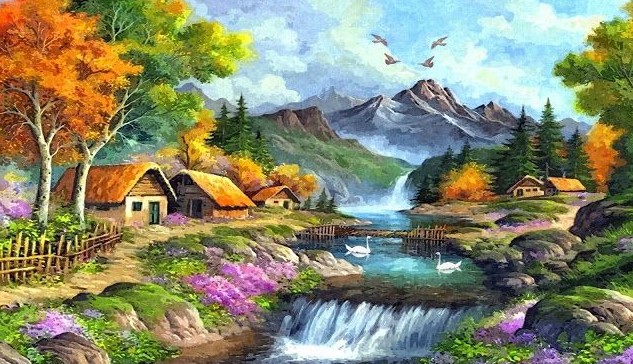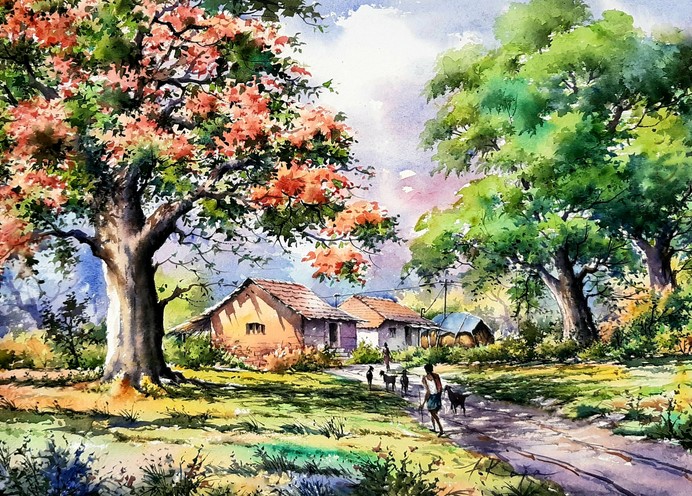
Painting Nature: Unraveling the Beauty of Landscape Art is a comprehensive guide to the art of landscape painting. It explores the history of landscape painting, the techniques used to create beautiful works of art, and the various styles of landscape painting. It also provides tips and advice on how to create your own landscape paintings. This book is perfect for anyone interested in learning more about the art of landscape painting, from the beginner to the experienced artist. With its detailed explanations and helpful illustrations, Painting Nature: Unraveling the Beauty of Landscape Art is an invaluable resource for anyone looking to explore the beauty of nature through art.
Exploring the History of Landscape Painting: From Ancient to Modern Times
Landscape painting has been a popular art form for centuries, with its roots stretching back to ancient times. From the earliest cave paintings to the works of the Old Masters, landscape painting has evolved and changed over the years, reflecting the changing styles and tastes of the times.
In ancient times, landscape painting was used to depict the natural world and to capture the beauty of the environment. Ancient Egyptian paintings often featured scenes of the Nile River and its surrounding landscape, while ancient Greek and Roman paintings often depicted the gods and goddesses of their respective pantheons in natural settings.
The Middle Ages saw a shift in landscape painting, with the introduction of religious themes. Paintings of the time often featured religious figures in natural settings, such as the Garden of Eden or the Crucifixion. This trend continued into the Renaissance, when artists such as Leonardo da Vinci and Michelangelo began to explore the use of light and shadow to create more realistic landscapes.
The Baroque period saw a further evolution of landscape painting, with artists such as Claude Lorrain and Nicolas Poussin creating works that featured dramatic lighting and complex compositions. This trend continued into the Rococo period, when artists such as Jean-Honoré Fragonard and Jean-Antoine Watteau began to explore the use of color and texture to create more romanticized landscapes.
The 19th century saw a shift in landscape painting, with the introduction of the Impressionist movement. Artists such as Claude Monet and Pierre-Auguste Renoir began to explore the use of light and color to create more abstracted landscapes. This trend continued into the 20th century, with the introduction of modern art movements such as Cubism and Surrealism.
Today, landscape painting continues to evolve and change, with artists exploring new techniques and styles to create works that reflect the changing world around them. From ancient times to the present day, landscape painting has been a popular art form, and its history is one that is sure to continue to fascinate and inspire.
Capturing Nature’s Beauty: Tips and Techniques for Painting Landscapes
Capturing Nature’s Beauty: Tips and Techniques for Painting Landscapes
Painting landscapes can be a rewarding and fulfilling experience. With the right techniques and tools, you can create stunning works of art that capture the beauty of nature. In this article, we will provide some tips and techniques to help you create beautiful landscape paintings.
First, it is important to choose the right materials. Quality paints, brushes, and canvas are essential for creating a successful landscape painting. Choose paints that are lightfast and have good coverage. Select brushes that are suitable for the type of painting you are doing. For example, if you are painting a detailed landscape, you may want to use smaller brushes.
Second, it is important to plan your painting. Before you begin, take some time to sketch out your composition. This will help you determine the best placement of elements in your painting. Consider the light source, the colors you want to use, and the overall mood of the painting.
Third, it is important to use the right techniques. When painting a landscape, it is important to use techniques such as layering, blending, and glazing. Layering allows you to create depth and texture in your painting. Blending helps to create smooth transitions between colors. Glazing is a technique that involves applying thin layers of transparent paint to create a soft, luminous effect.
Finally, it is important to practice. Painting landscapes can be challenging, so it is important to practice and refine your techniques. Experiment with different materials and techniques to find what works best for you.
By following these tips and techniques, you can create beautiful landscape paintings that capture the beauty of nature. With practice and dedication, you can create stunning works of art that will be admired for years to come.
Conclusion
Painting Nature: Unraveling the Beauty of Landscape Art is an insightful exploration of the history and techniques of landscape painting. It provides a comprehensive overview of the genre, from its origins in the Renaissance to its modern-day interpretations. Through its detailed analysis of the works of renowned landscape painters, it reveals the beauty and complexity of the natural world. By exploring the various elements of landscape painting, this book provides an invaluable resource for anyone interested in the art of painting nature.

